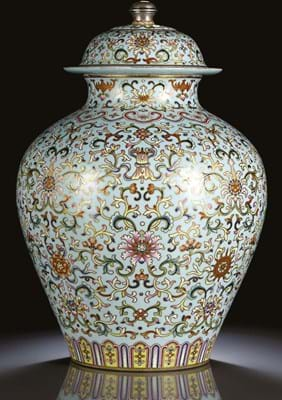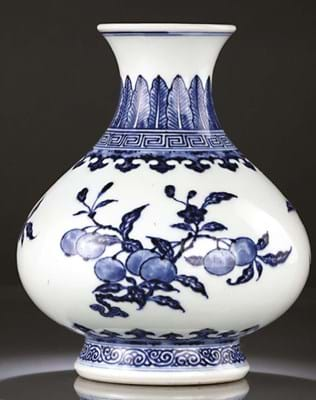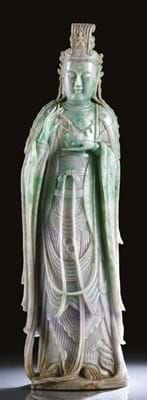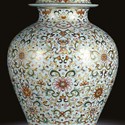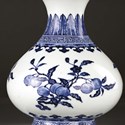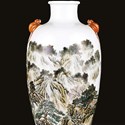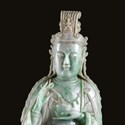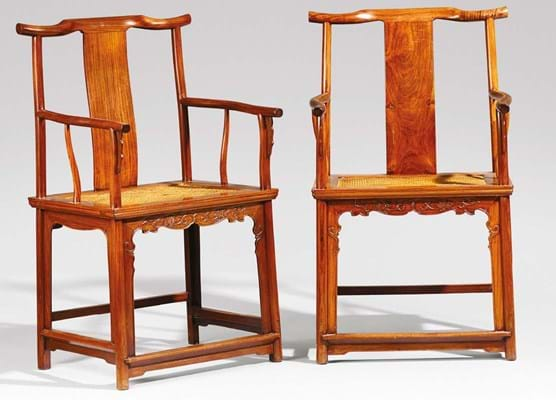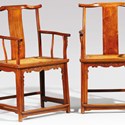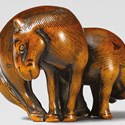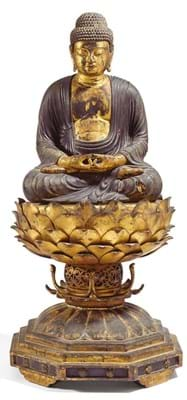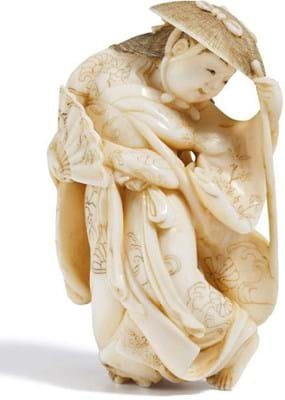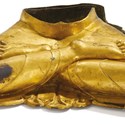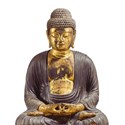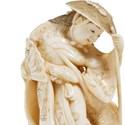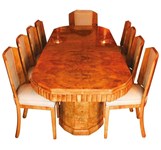Auction houses in Cologne and Salzburg could not compete with this but nevertheless lively, albeit sometimes selective, bidding at their auctions emerged. As a rule Asian dealers and collectors remain the top buyers and in most cases, underbidders.
Stuttgart and Salzburg
For several years, Stuttgart saleroom Nagel (33% buyer’s premium) has held its main auctions of Asian art in Salzburg.
This year’s spring sale on June 6-7 confirmed the pattern of previous sales: virtually all of the consignments came from European collections and the vast majority of buyers from Asia.
This time around, the bidders were choosier than in earlier sales, so that at the close of play only just over half the lots had found buyers. However, the auction house could still boast a row of six-figure prices, often way above the catalogue guides.
A 19in (48cm) high Qianlong porcelain vase with cover, decorated in convincing imitation of cloisonné work was bought at an English country sale many years ago, according to the European consignor.
It was expected to bring €40,000-60,000, but finally went to a buyer from mainland China for €290,000 (£261,260), against stiff competition from numerous compatriots.
The same bidding battle greeted an 8in (21cm) high imperial Yongzheng mark and period porcelain vase with underglaze blue painting of fruiting branches known as The Three Abundances, a motif inspired by pieces from the Yongle period. Estimated at €20,000-30,000, it went back to China for €285,000 (£256,755).
The deity Guanyin plays a special role in eastern religion, in particular as the goddess of compassion.
Even so, the ferocious bidding for a very large, 21in (53cm) high carved jade figure of Guanyin dated to the 20th century came as something of a surprise.
“Asian dealers and collectors remain the top buyers and in most cases, underbidders
It had an estimate of €10,000-15,000 but bidders were prepared to go well beyond the guide and the hammer only fell at €180,000 (£162,160).
This was even higher than the result for a 6½in (17cm) high partly gilt bronze figure of a seated Guanyin from the 12th or 13th century, which went from €20,000 to €164,000 (£147,750).
Another higher than predicted price was the €155,000 (£139,640) for a 13in (34cm) high Republic period porcelain vase painted with a continuous landscape and applied bats as handles that was guided at €5000-8000.
The vase had a seal mark and signature corresponding to 1937 and as painted by Zhang Zhitang from Xingjiang in China. It came from a European collection assembled from 1960-90. In this case the buyer was not from China, but the US.
Armchairs back to China
Lempertz (24% buyer’s premium) presented its selection of Chinese and Japanese works of art in Cologne on June 7-8.
As elsewhere, bidding was highly selective and several of the potential highlights missed their mark.
The top price of the sale was achieved for a pair of armchairs made from the rare type of rosewood known as huanghuali, often, but not exclusively, used for imperial pieces.
These chairs were purchased by a French diplomat in the 1930s and came from a German collection. They are now en route for China, having sold for a mid-estimate €67,000 (£60,360).
Over recent years, Lempertz have devoted a lot of energy to selling works of art from Japan, including netsuke from the Kolodotschko collection and other sources.
Consistent bidding for netsuke emerged in this sale and among the sought-after pieces was a late 18th century boxwood group of two horses, estimated at €2500-3000, which finally went to a German collector for €12,000 (£10,810).
Unexpected results
On June 12 in Cologne, Van Ham’s (29/25% buyer’s premium) Asian art sale also contained a number of unexpected results.
The auction house was surprised by the interest for a fire-gilt-bronze fragmentary lower section of a seated Buddhist figure.
It was obviously difficult to catalogue and was described as ‘Tibet/Nepal. Probably 15th/16th century or later’. Several bidders drove the price to €70,000 (£63,065), more than twice the lower estimate, paid by a Chinese bidder.
The 18th century Qianlong-period carved red lacquer plate in the shape of a lotus flower (previewed in ATG No 2395), was one of several pieces from the collection of Roland Sonderhoff and more than lived up to its expectations, doubling the guide to sell to a Chinese bidder for €43,000 (£38,740).
In Cologne international interest also emerged for Japanese works of art, most prominently for the 2ft 4in (72cm) high figure of a seated Buddha, Amida Nyôrai, dated to the Kamakura Period (1185-1333).
The figure itself was carved in wood with lacquer and gilt, while the lotus blossom base also incorporated bronze elements.
The height makes it likely that it was created for a temple. It had belonged to two US collections before coming into possession of the current consignor and went to an unnamed buyer for a top-estimate €60,000 (£54,050).
A south German collector had the most staying power when it came to the netsuke.
Among his purchases was the ivory figure of the 17th century dancer Izumo no Okuni who founded the tradition of kabuki theatre. The 2in (5cm) figure was carved in 1900 by Kawahara Ryo and was expected to bring €12,000-14,000, but was pushed to €30,000 (£27,025).
The same buyer also secured an ivory figure of a seated Kirin by an 18th or 19th century craftsman for €20,000 (£18,020), more than double the top estimate.
£1 = €1.10


